|
Scarlet and Gray–Ground Zero of College Pigskin
Introduction to Ohio State Pigskin at Camp Randall!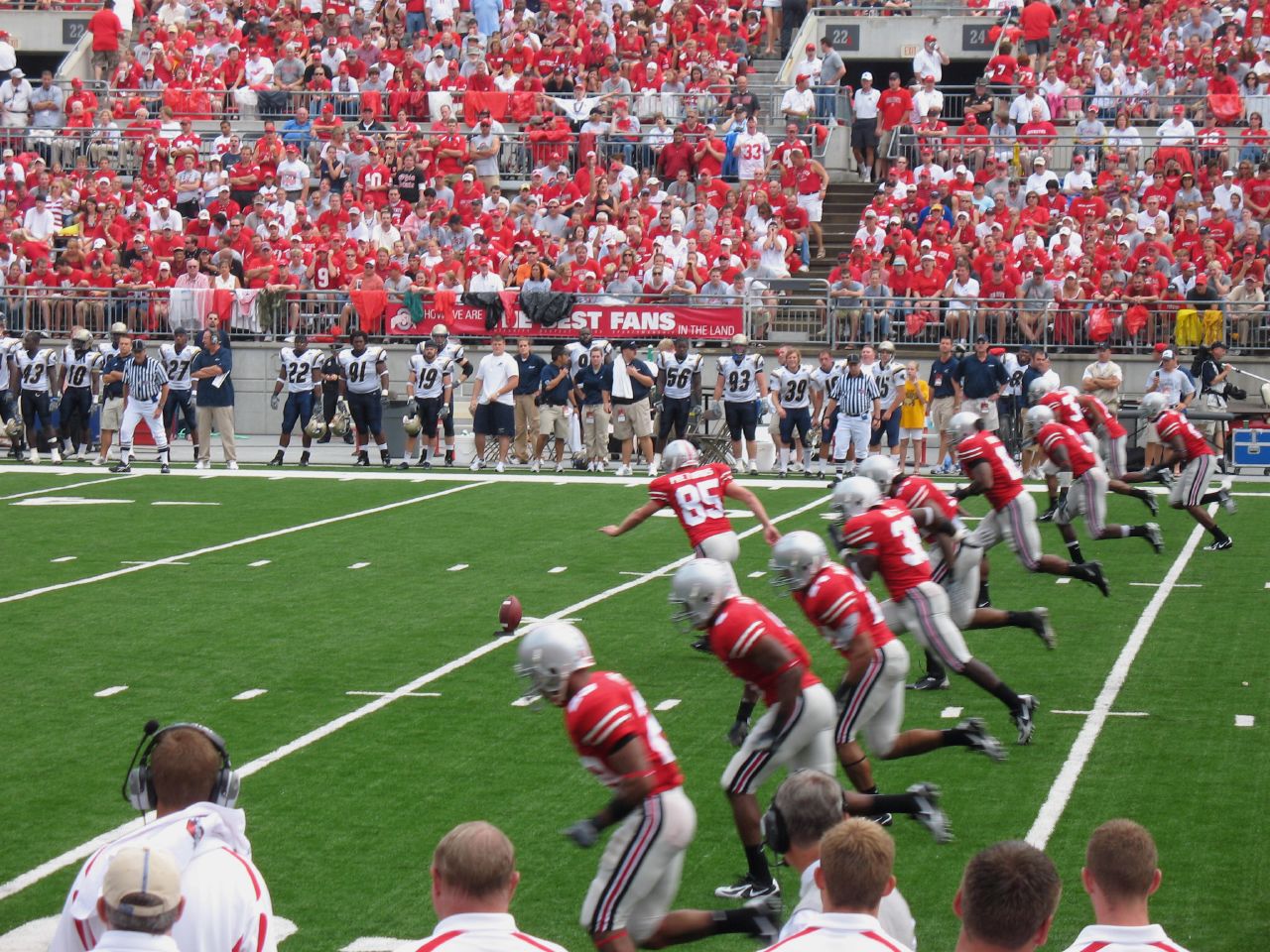
I distinctly remember the Buckeyes team that year that finished 6-3.
This was a really good TEAM that didn’t quite have the muscle to get
through the Big 10–for many years the arguably preeminent college sports
conference. Seven players from the 1962 Ohio State TEAM were drafted
into pro football (Vogel, Sanders, Moeller, Francis, Foster, Kattenrich
and Middleton). Other than the 1963 Rose Bowl, many of these games were
three yards and clouds of dust. Today it’s high octane air shows in all
of football.
Many years passed and the Badger football tickets became cheaper
because of the 22 game college losing streak (an unheralded NCAA record
at the time) in the mid 1960s. I was even there watching countless
missed field goals as Wisconsin had Indiana’s 1968 national championship
TEAM on the ropes all day only to lose again.
It wasn’t until a
guy called “The Roadrunner” appeared in a Badger uniform that Camp
Randall finally woke up. This small framed halfback was a truly feared
guy–even Ohio Staters talked about him. As I sat in the stands on yet
another football Saturday hoping to witness history, it was not meant to
be. With Archie Griffin (2 time Heismann winner) on the other side,
Wisconsin fell to Ohio State again.
Now I was a bit older but still couldn’t afford a great seat. I was
still going because you just never know. It was a great close game back
in the early 70s after the campus finally quieted down and the world was
again right (at least for a paper boy). I was probably less inhibited
back then and talked to many of the seated Buckeye fans. These Ohio
State fans all had an air of invincibility, football knowledge and
confidence until the final whistle. They came to Madison to cheer their
Buckeye TEAM on, weather the cold, drink decent beer and hopefully have
Archie march his way ito the Heisman. I distinctly remember these fans
never smiling–EVER! The facial muscles relaxed as they left their seats
after the game ended. But no smiles. My God–these Ohio State folks are
damn serious. We’ve just never had this level of seriousness and
commitment to a game at the UW. Don’t think I could pay enough for the
right to be in the stadium with such a level of sports seriousness.
Ohio State pigskin is a regimented culture represented by a deep need
to win and play fair. There will be no change in attitude or facial
expressions if the team wins 14-13, or lays an egg on Iowa 66-0. Winning
is expected, repeated and requires an increase of Zoloft dose if the
Buckeye TEAM actually (God forbid) loses. Surprisingly Camp Randall has
proven to be an Ohio State stumbling block for years. The UW is a
party/academic school that slowly became concerned about football wins.
Winning and enjoying it gives every UW professor and student a chance to
be uninhibited for a few hours. At Ohio State however, winning is a
gold standard like no other. Maybe it’s just the fans that traveled to
Madison, or its Ohio genetics or overcast weather that makes these
Buckeye fans become morbidly serious over a game. Who knows? Maybe there
is nothing else to do in Ohio than cheer these Buckeyes on. By
comparison, life goes on in Madison with a loss (I’ve handled many). But
not in Columbus where winning every week continues to be like a brand
new Olympics for these gladiators at Ohio Stadium. This is precisely why
Ohio Stadium on a fall home game day is Ground Zero for College
Pigskin.
Rutherford B. Hayes Got It Going!
A “no name” Reconstruction president of the United States really
mainstreamed Ohio State into a full college. Previously it was Ohio
Agricultural and Mechanical College established in 1862 with the Morrill
Act. As governor of the state in 1878 Rutherford B. Hayes established
the school as The Ohio State University where it became a complete
University, consistent with Hayes’s three term gubernatorial social and
educational directives. The University began with 24 students in 1873
and had its first graduation of six in 1878. Today Ohio State is the
third largest campus in the United States with regional campuses in
Marion, Wooster, Lima, Mansfield, and Newark. Ohio State is an elite
public Ivy University with high entrance requirements and academic
standards. The university has hundreds of student academic and social
organizations along with conventional fraternities and sororities. The
athletic department is second to none with a budget in the hundreds of
millions. Virtually every sport is played at every level including
intramural, club and varsity. The Ohio State University has ranked quite
high academically in multiple disciplines by varying rating
organizations. Its alumni have done well as individuals and have
benefitted society in many endeavors including science, politics, art,
sports, entertainment, medicine, dentistry and business. Endowments,
research and internet technology also rank highly among competing
private and public universities.
Pigskin draws undergraduate
and graduate students both directly and indirectly. Ohio natives and
non-natives from all across the globe come to Columbus for academics.
You cannot be a lackadaisical student and graduate from Ohio State.
Underlying the academics is football. The Buckeye pigskin experience is a
high tier of understanding, knowledge and prowess. Chatter,
conventional and social media, game day hype and an opportunity to
escape reality and exhaust your lungs all come together uniquely at Ohio
State. Governor Hayes had no idea what he began when he renamed Ohio
A&M to The Ohio State University.
Rutherford B. Hayes
retired a great president who oversaw Reconstruction. His election was
the closest in history, winning 185 to 184 electoral votes. The race was
not decided for months after election day due to many recounts. In 1881
Hayes retired to Spiegel Grove, his home in Fremont, Ohio. He served a
vibrant one term presidency and witnessed the beginning of collegiate
sports at The Ohio State University prior to his death in 1893.
Traditions Second to No Other School!
The Ohio State University has two school fight songs:
- Buckeye Battle Cry
- Across the Field
At the end of every home game alumni, fans, students and players sing Carmen Ohio
(Latin for Song of Ohio). Many fans still enjoy listening or singing
"Hang on Sloopy" during games. Ohio Stadium provides a great escape for a
day and memories that can last forever. As you read this article listen
in and truly get the feel of Ohio Stadium. The songs and cheers at Ohio
Stadium and throughout Ohio include:
Songs
- Across the Field (1915)
- Beautiful Ohio (1918)
- Buckeye Battle Cry (1919)
- Campus Echoes (1952)
- Carmen Ohio (1903)
- Down by the Ohio (1902)
- Fanfare for a New Era (2001)
- Hang on Sloopy (1965)
- I Wanna go Back to Ohio State (1930)
- Le Regiment de Sambre et Meuse (1871)
- Round on the End and HIgh in the Middle (1922)
- We Don’t Give a Damn for the Whole State of Michigan (1940)
Cheers
- Let’s Go Bucks (1983)
- Ohio–Let’s Go Bucks Cheer (2009)
- The Hey Cheer (1972)
- The Neutron Dance (1984)
- Seven Nation Army (2003)
- Short Cheers (2008)
The songs and cheers are engrained into every Ohioan who cares about
the University and its football program. Though Ohio State’s tentacles
are wide, most of the real roots of The Ohio State University program
come from within Ohio itself. Unlike Notre Dame with its million “subway
fans,” the Buckeye fan base consists of relatives living within the
state–hating the Wolverines–attending Ohio State and their like of the
players, coaches and TEAMS of The University. Ohio State realizes
immense exposure throughout the world for its excellent sports programs,
especially pigskin.
The Buckeye and other aligned web sites
summarize the historical nature of Ohio State’s football traditions from
helmets to homecoming. Few schools can match this tremendous pigskin
tradition.
Football Traditions
Buckeye Leaves

|
The tradition of placing Buckeye Leaves on the Ohio State helmets
started in 1968 when Woody Hayes and longtime trainer Ernie Biggs
changed the look of the Ohio State uniforms. The new look included names
on the back of the jerseys and a wide "Buckeye stripe" on the sleeves
of the jersey believed to be the first of its kind in the sport of
football. |
Victory Bell

|
Located in the southeast tower of Ohio Stadium, the Victory Bell is
rung after every Ohio State victory. It was a gift of the classes of
1943, 1944 and 1945. Resting 150-feet up in the southeast tower, members
of Alpha Phi Omega ring the bell after victories, a tradition that
began after Ohio State beat California Oct. 2, 1954. On a calm day, it
is said the bell can be heard five miles away. The bell weighs 2,420
pounds and cost $2,535 to install. |
Scarlet & Gray

|
Ohio State's official school colors since 1878, Scarlet and Gray
were chosen by a group of three students in a lecture room in University
Hall because "it was a pleasing combination...and had not been adopted
by any other college," noted selection committee member Alice Townshend
Wing. |
Brutus Buckeye

|
One of the more visible symbols of Ohio State athletics is Brutus
Buckeye, the school's mascot. In 1965, an art student designed and
introduced the first Brutus, while the name was chosen in a contest. The
mascot began as a hardened paper mache affair that looked like a
bowling ball with legs. In 1975, a radical new Brutus was designed with a
prune-like head and a man's body. That attempt was booed off the field
and was re-worked, giving way to a mascot comparable to the beloved
present-day Brutus.
The original choices for Ohio State's mascot
included a ram, an elk, a moose and the leading candidate, a male deer.
Due to the skittish nature of deer, the idea of a mascot was tabled
until January 1941 when "Chris," a German police dog owned by an
assistant cheerleader, made an appearance at a basketball game. The
dog's career was short-lived and Ohio State remained without an official
mascot until the 1960s. |
Cheerleaders

|
Buckeye cheerleaders are a constant source of support at all
athletics events. The squad took second at the 2001 College Cheerleading
National Championship, its highest finish since winning the 1993 title,
and has placed first in the east region in 13 of the last 16 years. The
cheerleaders make appearances all over the state throughout the year. |
Gold Pants

|
A gold charm replica of a pair of football pants is given to players
and coaches following wins over Michigan. The tradition started in 1934
when first-year coach Francis Schmidt told those wondering how Ohio
State would fare with its nemesis from Ann Arbor: "They put their pants
on one leg at a time just like everybody else." Schmidt's Buckeyes then
went and defeated Michigan four-consecutive times, all by shutout. |
Buckeye Grove
|
Since 1934, a Buckeye tree has been planted in honor of each of Ohio
State's All-American. Trees are usually planted in a pregame ceremony
at the spring game. With the renovation of Ohio Stadium in 2001, the
Buckeye Grove is now located at the southwest corner of the stadium. |
Senior Tackle

|
A last practice of the year tradition since 1913 where the seniors
hit the blocking sled one final time. For many years it was held
following the last practice prior to the season finale with Michigan.
But depending upon the Buckeyes' bowl obligation, it has sometimes been
moved to the last home practice before the team departs for its bowl
obligation. |
Tunnel of Pride
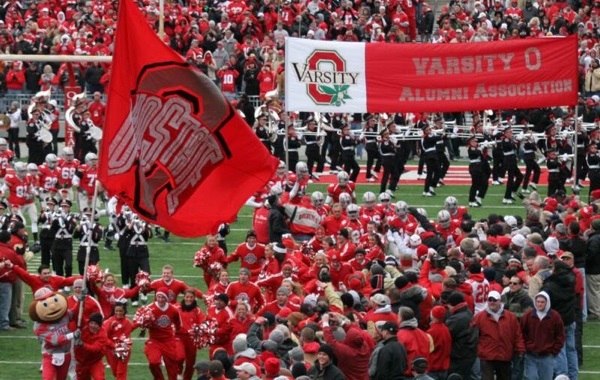
|
The brainchild of ex-Ohio State quarterback Rex Kern and former
Director of Athletics Andy Geiger, the Tunnel of Pride actually started
in 1995, when Notre Dame visited Ohio Stadium for the first meeting
between the two teams in nearly 50 years. In an effort to generate even
more emotion, excitement and enthusiasm than already existed, Kern and
Geiger reached out to former Buckeye football players who were attending
the game and asked them to form a tunnel for the team to run through as
it came onto the field. Thus a tradition was born, which is now
continued every other year when Michigan visits Ohio Stadium. |
Captain's Breakfast
|
Started in 1934, this annual event is held on homecoming weekend.
All past captains are invited back for a breakfast and to welcome in the
new captains. |
The IlliBuck Trophy

|
The winner of the Ohio State - Illinois game has received the
Illibuck trophy since the tradition began in 1925. Illibuck was a live
turtle, but has been a wooden replica since 1927. Also representative of
the rivalry is the peace pipe. Members of two junior honorary
societies, Bucket and Dipper of Ohio State and Sachem of Illinois,
annually meet at halftime of the Fighting Illini-Buckeye game to smoke
the peace pipe and present the "Illibuck" trophy to the winning school
from the previous year. |
The Michigan Game
|
The annual Ohio State-Michigan football game was No. 1 on a list of
the 10 Greatest Rivalries In Sports compiled by the editorial staff at
ESPN.com in 1999. There simply is no greater rivalry in college
athletics.
|
Homecoming
|
First recognized in 1912, Homecoming began as "Ohio State Day." It
was initiated by Professor (and later Ohio State President) George W.
Rightmire. Homecoming was designed to bring the alumni back to the
university and celebrate. The celebration has been noted, among other
things, for the decorating of Greek chapter facilities and university
dormitories. The parade is another tradition Buckeyes' hold high. The
parade did not become a time-honored tradition until it joined the
schedule permanently in 1965.
In 1926, student supporters wishing to
pull a practical joke on the university, convinced the community that
Maudine Ormsby was to be honored as queen. She was so popular on campus,
she won the vote. Maudine, pictured at the right, actually turned out
to be a cow, the only cow ever elected as homecoming queen. |
Block O
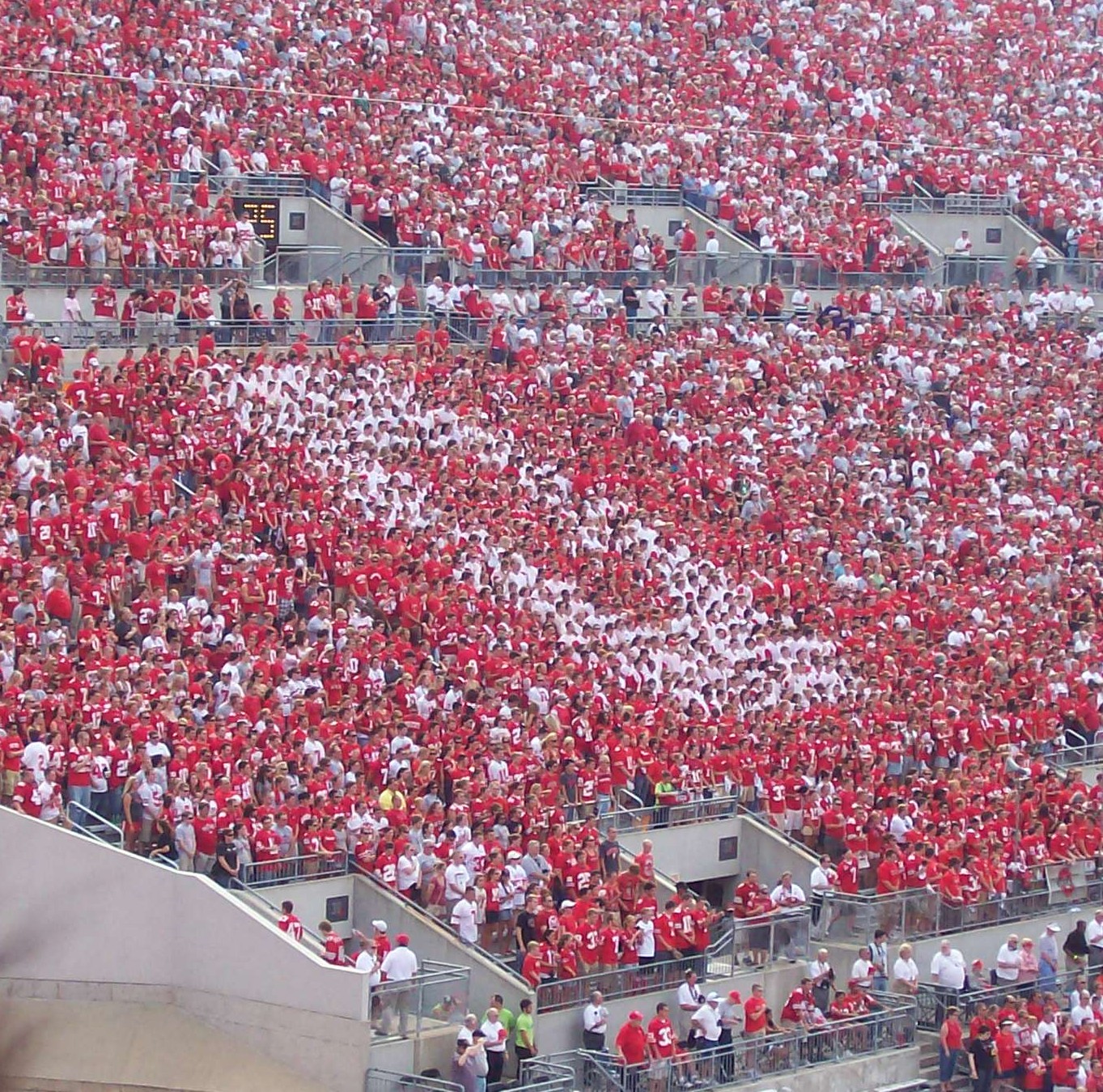
|
An Ohio State University and Ohio Stadium tradition, Block "O" is
celebrating its 65th anniversary this year. Known for spreading spirit,
starting cheers and performing card stunts, Block "O" was founded in
1938 by Clancy Isaac. After seeing a cheering section at the University
of Southern California, Isaac decided that it was something Ohio State
needed. Sixty-five years later, Block "O" is Ohio State's largest
student organization on campus and has gained local and national
recognition. |
Retired Jerseys

You won't see any Buckeyes wearing the numbers 22, 27, 31, 40, 45, 47
or 99 on the field, but those digits can be easily spotted inside Ohio
Stadium. Seven Ohio State players have had the ultimate honor of having
their numbers retired. To have a number retired, a player must have
graduated from Ohio State, or have been in good academic standing upon
departure from Ohio State, in the case of leaving early for a
professional career. He also must have won the Heisman Trophy, the
Maxwell Award, the Walter Camp Award, the Associated Press Player of the
Year Award, the Football Writers Player of the Year Award or the
American Football Coaches Player of the Year Award.
Start Date: October 30, 1999
Jerseys Retired:

- #45 Archie Griffin (1999)
- #31 Vic Janowicz (2000)
- #40 "Hop" Cassady (2000)
- #22 Les Horvath (2001)
- #27 Eddie George (2001)
- #47 "Chic" Harley (2004)
- WH Woody Hayes (2005)
- #99 Bill Willis (2007)
Wall of Fame
In the Buckeye football team meeting room within the Woody Hayes
Facility is the "Wall of Fame" which contains letters from former
Buckeye players who have summed up their feelings of what it means to be
a Buckeye. Current players can take the opportunity to digest those
words at any time by simply reading the letters.
Carmen Ohio
October 25, 1902 is a dubious day in Ohio State football history. The
Buckeyes lost their fourth ever meeting to Michigan by an 86-0 count,
to this day still the worst loss in school history. From great despair
though, dogged determination arose that continues to define Ohio State
football 103 years later. On the train back from Ann Arbor, team member
Fred Cornell put pen to paper. The result: We know it now as Carmen
Ohio, which was published in 1906 and later adopted as the school's
official alma mater. The first part of the title is derived from the
Latin word "Carmen," meaning "song" or "poem." A new tradition with
Carmen Ohio was established in 2001. Upon completion of home games–win
or lose–Buckeye players and coaches congregate with the cheerleaders to
sing Carmen Ohio with accompaniment from the marching band. This
tradition created unforgettable scenes following the victories over
Michigan in 2002 and 2004.
Ohio Stadium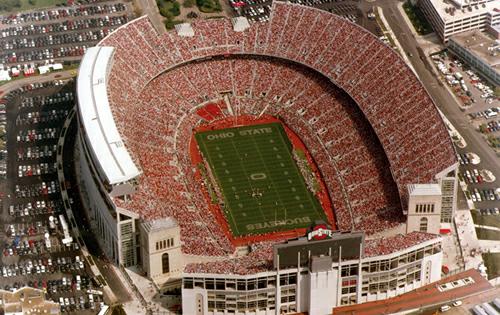
Nicknamed "The Horseshoe," this cathedral of college football was
opened in 1922. It now seats 101,568 and the total capacity is larger.
For 84 of its 116 year history, Ohio State football has been played in
venerable Ohio Stadium, which is listed on the National Registry of
Historic Places. The stadium was originally built to seat 66,210. That
figure itself was considered outlandish. At the time, overflow crowds at
Ohio Field would barely reach 20,000. Thanks to the popularity of
Charles "Chic" Harley in the late 1910's–and the school's first Big Ten
championships–Ohio State football was reaching unprecedented heights.
Director of Athletics Lynn W. St. John and Thomas French, a professor
and member of the athletic board, were the visionaries that saw a need
for a new stadium. “The Horseshoe" was given a massive facelift from
1999-2001, making it one of the finest facilities in all of college
football. Ohio Stadium is as vital to the Buckeye experience as the game
itself. Since 1949, Ohio State has never finished lower than fourth
nationally in average home attendance. From 1951 through 1973, Ohio
State led the nation in attendance 21 times, including 14 straight from
1958 to 1971. That support has transitioned to the Buckeyes play on the
field as well. All-time, Ohio State has won nearly 77% of its games
played in the “The Horseshoe," including 89% since 2001.
Brutus Buckeye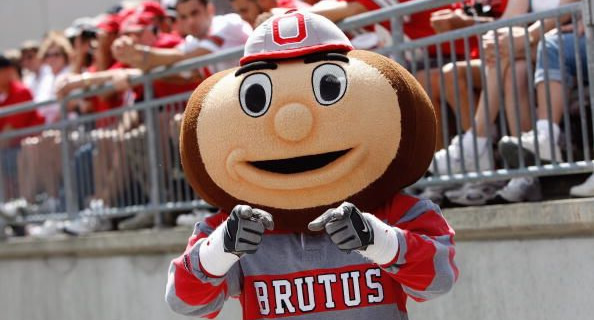
One of the more visible symbols of Ohio State athletics is Brutus
Buckeye, the school’s mascot. In 1965 an art student designed and
introduced the first Brutus, while the name was chosen in a contest. The
mascot began as a hardened paper mache affair that looked like a
bowling ball with legs. In 1975, a radical new Brutus was designed with a
prune-like head and a man’s body. That attempt was booed off the field
and was re-worked, giving way to a mascot comparable to the beloved
present day Brutus.
The original choices for Ohio State’s mascot included a ram, an elk, a
moose and the leading candidate, a male deer. Due to the skittish
nature of deer, the idea of a mascot was tabled until January 1941 when
“Chris,” a German police dog owned by an assistant cheerleader, made an
appearance at a basketball game. The dog’s career was short lived and
Ohio State remained without an official mascot until the 1960s.
TBDBITL
To some, they are referred to simply as "The pride of the Buckeyes."
Others prefer the more vigorous title of T.B.D.B.I.T.L. (The Best Damn
Band in the Land). By far Ohio State's longest running tradition, the
band's roots date back to 1879. Then and now: Script Ohio circa 1938 and Script Ohio in 2010
Stadium fans know that kickoff is just moments away when the band
makes it entrance down the ramp at the north end of the field, paced by
the drum major. The entrance, the brainchild of band members Bill
Knepper and Elvin Donaldson, started in 1928.Seventy-eight years later,
virtually the same entrance is still used. Eugene Weigel, Ohio State
band director from 1929-1938 changed the instrumentation to all-brass in
1934.
The current band lists 225 members, still sans woodwinds.
The incomparable Script Ohio is a band formation that takes three and a
half minutes to execute. It begins with a triple "Block O" formation
which unwinds at the direction of the drum major into the word Ohio,
literally written by marching band members. It's capped off with the
dotting of the "i" in which a sousaphone player high steps from the
second "o" to properly complete the "i," much to the delight of the
crowd. To be eligible for the honor, a sousaphone player must be in his
or her fourth year. Fifth-year members of the band may do so, but only
after all four-year students have been chosen. Only eight non-band
members have ever dotted the "i."
Walk to the Horseshoe
Each home game, the football team walks as a single group to the
Skull Session to address the fans. After the Skull Session, the team
proceeds through a tunnel of fans to Ohio Stadium to begin their final
preparation for the game at hand./p>
Skull Session
The warm-up routine of the Ohio State University Marching Band takes
place in St. John Arena, right across the street from Ohio Stadium, two
hours before kickoff of home games. In 1932, band director Eugene Weigel
began having his marching band memorize the music they would be playing
that week. Before game-time, the band would go through its routine as a
final rehearsal. For 24 years it went on in the band's rehearsal hall,
before moving inside St. John Arena in 1957. Along the way, the format
was tweaked to make it more of a pep-rally atmosphere, and crowds have
responded, often to the tune of over 10,000 people. In 2001, Coach
Tressel began bringing the football team by the skull session on their
way into the stadium for the game. Now, beginning with Coach Tressel, a
senior addresses the crowd as well, adding to the frenzied environment.
Senior Tackle
A last practice of the year tradition since 1913 where the seniors
hit the blocking sled one final time. For many years it was held
following the last practice prior to the season finale with Michigan.
But depending upon the Buckeyes’ bowl obligation, it has sometimes been
moved to the last home practice before the team departs for its bowl
obligation.
Captain’s Breakfast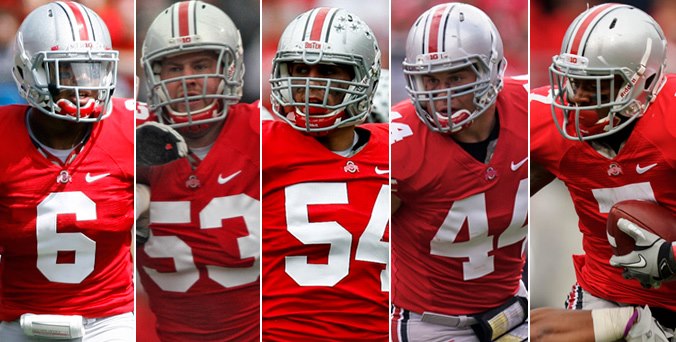
Homecoming is always a special event for those returning to Columbus
in the fall. However, for one select group it's an annual opportunity to
continue to provide leadership to the Ohio State program. The weekend
of Homecoming, every former Buckeye captain is invited back to take part
in the captain's breakfast. The current captains are welcomed into the
club, and given mugs with their names and season engraved on it.
Columbus businessmen Walter Jeffery, who believed past captains should
be honored, started this tradition at Scioto Country Club back in 1934.
Pay Forward
Woody Hayes used to have a saying. He would drop it into
conversations all the time. “You can never pay back,” he would say. “So
you should always try to pay forward.” Paying Forward Today: Athletes
from all of the varsity sports at The Ohio State University take time to
give back to the community and "pay forward" in a number of different
ways with a number of organizations. Each Friday before Ohio State home
football games, members of the team take some time to visit with
patients at both Children’s Hospital in Columbus and the Arthur G. James
Cancer Hospital. These hospital visits date back to the days when Woody
Hayes roamed the sidelines.
Block OAn Ohio State University and Ohio Stadium tradition, Block “O” is
celebrating its 65th anniversary this year. Known for spreading spirit,
starting cheers and performing card stunts, Block “O” was founded in
1938 by Clancy Isaac. After seeing a cheering section at the University
of Southern California, Isaac decided that it was something Ohio State
needed. Sixty-five years later, Block “O” is Ohio State’s largest
student organization on campus and has gained local and national
recognition.
Mirror Lake
Before the Ohio State/Michigan game at the end of the season, Ohio
State students typically jump into Mirror Lake located on campus the
Thursday night before the game. The tradition is thought to bring good
luck to the football team the following game day.
Tunnel of Pride
The Tunnel of Pride began with the 1994 Michigan game when all former
players who were in attendance formed a tunnel through which the team
ran to take the field and Ohio State beat its rival that day, 22–6. Rex
Kern, quarterback of the 1968 National Championship team, and then
Director of Athletics Andy Geiger, together used the concept as a means
of connecting current Buckeyes with those who played before them. The
Tunnel of Pride was next formed for the 1995 Notre Dame game which the
Buckeyes also won. In each home game against Michigan since, the
tradition has been repeated.
The Hive and Pre-game Circle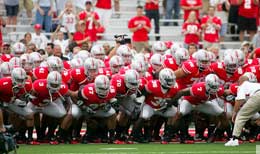
Tressel brought to the Buckeye football program two pre-game
traditions he developed at Youngstown State. Prior to its warm-up
routine before every football game, the team exits the locker room as a
unit in a controlled manner, linked arm-in-arm in a group known as "The
Hive." After warmups the team returns to the locker room, and when it
next appears, runs onto the field and forms a circle of players around
the strength coach; then they go through their warmup routine.
No other school has the tradition, spirit and collegiate football
spectacle quite like Ohio State. The great tradition of fundamental
football combined with fan and alumni who subscribe to the university
and its traditions associated with pigskin easily makes Columbus, Ohio a
premier place to be on a Saturday game day.
Recruiting Roads: US 23, US 33, I – 70, and I – 71 are well traveled by elite Ohio coaches and players.
Ohio State’s competitors seemingly are at a great coaching
disadvantage. If you have coaching ability and the thirst it takes to be
successful, then Ohio football at any level is first rate. As a state,
Ohio has a perfected system of Pop Warner, high school, D-I, II and III
collegiate players and coaches that allows the elite to march into Ohio
Stadium when its time. This is an informal de facto Communist-like
regimented sports production system in effect which leads to Big 10 and
national championships. Excellent players and coaches stay within the
state and perform and coach in Ohio itself. Few really good players or
coaches slip out of the state. There are clearly many hurdles and real
road blocks for the elite to leave the state because frankly, Ohio youth
football and coaching is as good as it gets anywhere in the United
States. Recruiting avenues to high schools and colleges flow freely
within the state. If you are worthy of playing college football then
signing an early letter of intent during your year of high school
graduation typically occurs. Ohio State obtains and publishes verbal
commitments even prior to the senior year in high school. Elyria OH senior Chase Farris officially commits to play football.

The Implementing a senior year first semester graduation from the
player’s high school occurs to a degree at Ohio State. This legal
practice began initially at Ohio State years ago and many D-I schools
have followed suit. This allows the incoming frosh recruit to begin as
early as January and participate in spring ball. Many of these frosh
will start or play important TEAM roles in the fall of their freshman
year. While scorned initially due to the student’s not formally
graduating with their high school class and missing prom, etc., the
program has proved beneficial to Ohio State’s football. These obstacles
have been overcome by these Ohio State second semester frosh coming back
for high school events. The Ohio State pigskin program just keeps
marching along as they build TEAMS to smother the rest of the
conference.
Transfer players from Division-II levels such as
Ashland, Findlay, Central State, Lake Erie, Ohio Dominican, Truman State
and Urbana occurs with exceptional players. Ohio State has a great walk
on program with many walk-ons becoming starters or role players. The
walk-ons are pursuing a dream and earn their scholarship by playing with
great incentive. Each high school historically has a knack for being a
linebacker or QB factory. The fine filter of all these schools leads to
the interstate road system funneling the elite into Ohio Stadium and
freshman Western Civilization at Columbus. Barbershop talk, coaching,
family pressure and the very football culture itself leads the elite
Ohio player and coach to remain on home turf. Rutherford B. Hayes
traveled these very roads on horseback and returned home to Ohio the day
after his presidency ended. Rutherford knew Ohio was a great place to
live. Let’s review the top Ohio high school football programs.
JJ Huddle’s Top 10 Football Programs of the Last Five Years
- Hilliard Davidson (MaxPreps Ranking: Not Ranked): The Wildcats own
two Div-I state titles, three regional titles, four regional final
appearances and five OCC titles the last five years. (59 wins since
start of 2006)
- Youngstown Ursuline (6): Irish have won three-straight D-V state titles and played in four straight state finals. (58 wins)
- Alter (7): The Knights are only a point shy of winning three state
titles in the last five years. They still have two state titles, three
state finals and four regional titles. (64 wins)
- Delphos St. John’s (NR): The Blue Jays have played in three straight
D-VI state championships and were five seconds away from three straight
titles. As is, DSJ won two titles and now owns six total. The Blue Jays
won 42 games the last three years. (52 wins)
- Youngstown Mooney (8): The Cardinals own two state titles and have
played in three state finals and four regional finals since 2006. (59
wins)
- Coldwater (10): The Cavaliers own one state title, three regional
titles and four MAC titles and have played in three state finals (and
four regional finals) the last five years. (61 wins)
- Marion Local (NR): Since 2006, the Flyers have won two state and four regional titles. (56 wins)
- Steubenville (NR): Big Red has run away with one state championship
and three regional titles in the last five years. It’s also played in
two state finals and four regional finals. (61 wins)
- Glenville (5): The Tarblooders depth and talent has produced a state final and two regional finals since 2006. (55 wins)
- St. Xavier (1): The Bombers have been Southwest Ohio’s top big
school with one state title and three regional finals the last five
years. (45 wins)
Honorable Mention
:
- Colerain (2)
- St. Ignatius (4)
- Maple Heights
- Chagrin Falls
- Mentor
Cradle of CoachesIt always seems that great football coaches come from the "Cradle of
Coaches": Miami of Ohio or other great high school and college football
schools within Ohio. The cradle has produced many elite head and
assistant coaches that traveled to Columbus for work after being
successful within the state. Names such as Les Miles, Urban Meyer, Lou
Saban, Bo Pelini, Gary Finkel, Dom Capers and Pete Carroll all have Ohio
roots. Fifteen of the past 20 contenders for the collegiate national
championship had Ohio connections by origin, playing or coaching.
Fifteen percent of D-I schools have Ohio rooted head coaches, despite
Ohio having only 4% of the US population. Woody Hayes, Paul Brown, Jim
Tressel, Sid Gillman, Bill Mallory, Bill Arnsbarger, George Little, and
Gary Moeller coached at both Miami of Ohio and Ohio State. Bo
Schembechler played under Woody Hayes in Oxford (Miami of Ohio), coached
under him at Ohio State and began the famous “Ten Year War” while
coaching at Michigan.
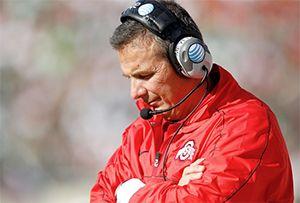
There are 36 NCAA football schools in
Ohio which all produce major talent in football players and coaches.
Endless streams of excellent coaches and former players within Ohio have
dreams of coaching at Ohio State. Fundamental football coaching is at
the very heart of all Ohio football. Youngstown State has produced
incredible collegiate coaches. This is a true salt of the earth football
program with roots in an Ohio steel manufacturing city. Jim Bollman,
Jim Tressel, and Mark Dantonio (MSU’s present coach) came to Ohio State
from Youngstown State University (YSU). Youngstown State won four
national championships in Division-II in the 1990s under Tressel before
he traveled to Ohio State.
Ohio University has contributed
immensely to NFL drafts and coaching talent at all levels. Cincinnati
has been a top program for many years nationally. Brian Kelly (present
Notre Dame Coach) had tremendous success at the University of
Cincinnati. Dayton produced Jon Gruden, a very successful collegiate and
NFL coach as well as TV football analyst. Dennis Green, NFL coach, was
also a product of the Dayton program. Toledo has had years of excellent
football program wins. Its early years produced an impressive 35 game
win streak. Divison III football in Mount Union of Alliance, Ohio has
produced 55 and 54 game win streaks, winning 109 of 110 games. Its
recent ten Div III national football titles has garnered great attention
for Mount Union and its football program. With its excellence a
cultural norm and the sport deeply rooted in its citizenry, Ohio
football sets a standard for the whole country. All these factors
contribute strongly to the Ohio State collegiate program because
competition and excitement for the sport within the state leads to all
the football programs becoming more successful. The development and
maintenance of Ohio football traditions is strengthened and has
contributions from hundreds of sources from Pop Warner to rival
competing Ohio pigskin programs.
Kick Ass Band and Spirit Squads Second to None
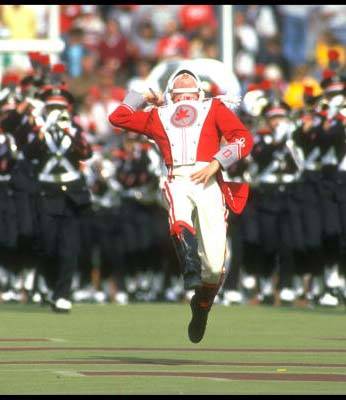
The world’s largest percussion and brass band plays at Ohio Stadium.
This is a true spectacle and many fans attend in large part to hear and
see these great young musicians perform. Fully twenty percent of the
Ohio State band are music majors. The band began in 1878 with a 12 piece
fife and drum corps. Multiple marching band techniques and innovations
were started at Ohio State including: floating or animated formations,
measured step marching, script writing and fast cadence with high knee
lift. All the Ohio State songs are played throughout the game. Intense
pre and post game and halftime shows are tremendous with a brass tonal
quality second to none. Ohio State requires tryouts (400 total
routinely) and if selected, an immense commitment to musical, performing
and marching excellence. The Ohio State band is held to a mental and
physical requirement to maintain the years of excellence. Women joined
the band in 1973 and the numbers now are fairly equal to men. The
marching band has kept its numbers near 225. The pattern of the band is
military British style. Multiple awards have been earned by the Ohio
State marching band including college band of the year. Some members
additionally play in the concert band. The Ohio State marching band
plays throughout Ohio and the US for parades, festivals, charity events,
hospitals and groups physically unable to attend concerts or football
games.
Entering Ohio stadium early allows a fan to witness a
big time college football drum major performing a “back bend” to the
extreme (forming the O). Initially the traditional entrance by the
Buckeye band occurs from the famed tunnel leading with "Buckeye Battle
Cry." A march to the opposition side of the field traditionally has the
Ohio State marching band playing the visitor’s fight song. Ohio State’s
fans, spirit squads, administration, coaches, players and the band
itself treats the opposition TEAM and its entourage with high respect.
The Ohio State marching band uniform is a complex outfit with many
parts. The entire uniform consists of: Plume, Hat, Eagle Ohio, red beret
with Diamond Ohio patch, short sleeve white dress shirt, black wool
military tie, dark Navy blue jacket, cross belts, breast plate for
belts, waist plates for belts, dark Navy blue trousers with appropriate
attaching belt or suspenders, spats, gloves, and military dress shoes.
No one walks out of Ohio stadium not getting their money’s worth from
the biggest spectacle in collegiate sports.
The Ohio State
percussion and brass band plays mostly at the Schottenstein Center as
well as Ohio Stadium along the banks of the Olentangy River. The band
has received national and International acclaim because of its musical
and marching excellence which adds to the atmosphere amidst the Buckeyes
playing fall tackle football. Season tickets are met with a strong
waiting list. Many feel what with the band, cheerleaders, dance team and
mascot along with its consistently winning pigskin program, The Ohio
State University is truly the very best spectacle in collegiate
football.
.jpg)
Cheerleading, the Dance TEAM, and Brutus (Buckeye Mascot) are all
part of the Ohio State Spirit TEAM. Unquestionably these students and
their performances bring fans and money into the program. The
cheerleading squad is extremely competitive. The hours required for any
of the Spirit squads are endless. The numbers of people watching
performances at Ohio Stadium, other Columbus and Ohio venues, as well as
through television is in the millions. Frequently television cameras
spotlight cheer squads. Ohio State cheerleaders obtain substantial
exposure at Ohio Stadium during pre and post game venues and being
featured with multiple routines throughout the games on cable TV. The
high requirements of Ohio State cheerleaders lead to consistently high
rankings among the elite in college sports. The intense time commitment,
athleticism and intensity learning cheers and routines (hardly anything
is routine) is extreme. Cheerleaders, dance squads and team mascots
spend an equal amount of practice and preparation time as D-I athletes.
The real crux of cheerleading is that through great individual effort
and TEAM commitment, a superb art and athletic product is produced. At
Ohio State it is quite difficult to be recruited or walk onto a D-I
sports TEAM–yet making a spirit TEAM of cheer or dance is even more
difficult.
Cheerleaders rank at the top of the heap in many
studies regarding life skills post college, including happiness, health,
marriage, job satisfaction, and offspring issues. Ohio State has a
superb alumni cheerleading tradition with fees, reunions and social
gatherings. The Ohio State spirit squads contribute unquestionably
directly to the University football tradition and indirectly, in
attracting great people and maintaining Ohio State as an elite
“Complete” University as defined by Rutherford B. Hayes.
Very Famous Buckeye Fans in the Stands!The list of Ohio State alumni receiving Pulitzer Prizes and Nobel Laureates as well as academic, sports, and political notoriety is
lengthy. Not that all of these folks are rabid football fans, but many
frequent Ohio State for football and other sporting and alumni events.
Additionally, arts and entertainment majors as well as business school
grads have contributed significantly to Ohio State and national causes.
Many of these alumni often attend games as it gives them a chance to
return to campus and relive some of the best moments in their lives.
Let’s review the alumni list and see who could be in the stands on any
given day.
- Kenneth Wilson was the 1982 Nobel Laureate in physics.
- Julia Keller was a feature writer and winner of a Pulitzer Prize in 1995.
- W. Ann Reynolds was the chancellor of two of the three largest collegiate academic institutions in the US (CSU and CUNY).
- R.L. Stine was a prolific Ohio State grad who authored many children’s books.
- George Steinbrenner, long time Yankee owner and shipbuilder, was a grad assistant under Woody Hayes.
- Patrick Markey produced "A River Runs Through It."
- Fred Silverman was a top ABC executive.
- Erin Moriarity turned into a CBS analyst and nine time Emmy award winner.
- Evelyn Lundberg Stratton is a current Ohio Supreme Court Justice.
- Paul Russon served multiple ambassadorial positions.
- General Curtis Lemay was a Buckeye and World War II Army Air Corps
commander who went on to became commander of the USAF Strategic Air
Command and later, Chief of Staff of the US Air Force.
- Esther S. Tekeuchi was a bioengineer who made cardiac defibrillators possible.
- Buckeye Paul Ebert served mankind by promoting advancements in pediatric heart surgery.
- Blaine Wilson garnered a silver medal in gymnastics in the Athens Olympics.
- Robert Knight and John Havilicek were leaders on some very famous Ohio State hoop TEAMS.
- Nick Swisher and Frank Howard were noted MLB players.
- Troy Smith outplayed the entire county in 2006 on his way to a Heisman Trophy.
- Meg Mallon, Tom Weiskopf and Jack Nicklaus were All Americans on the Ohio State golf squads.
- Zac Dalpe has played in the NHL and Kyle Veris played soccer for the MLS’s LA Galaxy.
The Ohio State University has maintained itself as a “Complete
University” by Rutherford B. Hayes’ standards. In fact Ohio State as an
elite public university brings out the very best in many of its
students, many of whom now attend Ohio State football games on a routine
basis. Undoubtedly due to the many accomplishments of Ohio State
alumni, the bleachers on any given fall Saturday are chocked full of
superstar alums. Let’s Review the Football Record a Bit!
For many years the Big 10 was essentially the Big 2 plus 8. Obviously
the Big 2 were Ohio State and Michigan. In the last ten years it has
not been a given that these two TEAMS will be on top for their final
rivalry game in late November. Specifically Wisconsin became a dominant
TEAM of the 90s with three Rose Bowl victories. Other TEAMS within the
conference have fared well in the Big 10 and nationally including Penn
State, Iowa, Northwestern, Michigan State and now the Cornhuskers. Today
the Big Ten is as balanced with conference football as any other NCAA
conference. The academic standards maintained within the conference have
kept a brake on potential national pigskin dominance by Big Ten member
schools. Playing winning football at Ohio State and obtaining a
meaningful degree is an accomplishment. Ohio State is a difficult place
to obtain a degree, however the education is as good as it gets. Above
average academic work beyond the football field is required.
As with many student athletes competing in NCAA sports, an extremely
high motivation for academic success and love of the sport must
coincide. It is substantially difficult to achieve in both endeavors,
but most of these Ohio State pigskin players “step up” and get their
degree. The rewards of athletic commitments go well beyond the Ohio
State winning records. Nationally the rate of maturation from NCAA
Division I football to the NFL is 3%. Ohio State goes well beyond this
mark. Hundreds of Ohio State pigskin grads have made their mark in the
NFL. Thousands of young adults maturing from this collegiate juggernaut
have been strong contributors to the entire Ohio pigskin culture of
fundamentals and winning football. If not in the NFL, these great young
adults become involved with football in some ancillary role as teachers,
administrators, coaches, trainers, recruiters, writers and media
experts.
Pigskin success didn’t come easy at Ohio State. In
fact this TEAM which began in 1890 lost its first 16 games to Michigan.
In 1922 Ohio Stadium was built. Ohio stadium is still a great sporting
venue with multiple facility improvements through the years. Most Ohio
State historians define the timetable of Ohio State football in terms of
coaches tenures beginning with Liley coercing Cole to coach an Ohio
State football TEAM in 1890. In the ensuing years it took a succession
of coaches before a winning season arrived with John Wilce in 1913. Over
the next 15 years he compiled a record of 77-38-9 while winning three
Big Ten conference titles. Two more conference titles occurred with Coach Francis Schmidt while
Coach Paul Brown led the Buckeyes to a national championship in 1942.
Following World War II the Ohio State program struggled until Woody
Hayes was hired as the dead coach in 1951. Woody was known for rigorous
practices, his “in your face” preaching of fundamentals and winning at
all costs. Hayes won 13 conference titles, 5 national championships and 4
of 8 Rose Bowls before being Hayes dismissed in 1978. Earl Bruce
succeeded Hayes and won the conference title his first year as head
coach, ultimately losing in the Rose Bowl. He was the AP coach of the
year his first year as head Ohio State coach.
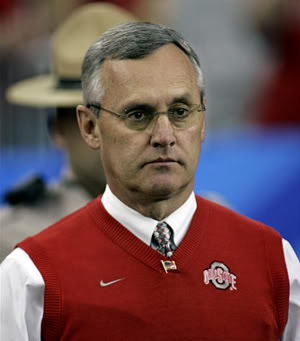
John Cooper picked
up the head coaching reins in 1987 and won multiple Big 10 titles. He
was ultimately dismissed for not defeating Michigan consistently
(2-10-1). Cooper didn’t win a national title (now expected by the Ohio
State fans). At this juncture Ohio State fans regarded winning as cure
for all evils within any program. Handing any Rose Bowl berths to
another school in the Big 10 (especially Michigan) became grounds for
dismissal as head coach at Ohio State.Unfortunately John Cooper was
forced to find employment elsewhere in 2001 despite four Big 10 titles.
The following year noted Div II national championship coach JIm Tressell
from Youngstown State arrived. Tressel coached from 2001-2010 and won 7
conference titles and 5 of 8 Bowl Championship Series games. However,
pressure from the NCAA due to rules infractions caused Tressel to resign
in 2011. Following his resignation Ohio State’s 2012 team was declared
ineligible for bowl participation by the NCAA. Assistant coach Luke
Fickell coached the Ohio State TEAM in 2011. Following the 2011 season
the former Florida coaching legend and Ohio State alum Urban Meyer
succeeded to the reins.
Ohio State’s pigskin record as of 2012
is 835–316–53 with a post season bowl record of 19-23. The record also
includes 7 national and 34 conference titles, 7 Heisman Trophy winners, 9
undefeated seasons, participation in 44 bowl games, 18 National
Football Foundation scholar athlete awards, 30 players and coaches
inductees to the College Football Hall of Fame and 78 All American
players.
Heisman Trophy winners Ohio State players have won the Heisman Trophy
seven times, which ties Notre Dame for the
most awards for any school. Archie Griffin
remains the only two-time recipient in the history of the award. 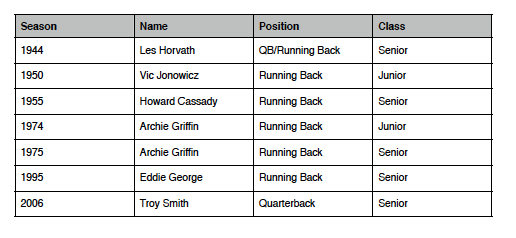
Lombardi Award
Ohio State players have won the Lombardi Award six times. Orlando Pace is the only two-time
recipient in the history of the award. This award is given annually to the best college lineman
whose performance and ability best exemplifies the discipline of Vince Lombardi.
• 1970: Jim Stillwagon
• 1973: John Hicks
• 1987: Chris Spielman
• 1995: Orlando Pace
• 1996: Orlando Pace
• 2005: A. J. Hawk
Maxwell Award
Given annually by the Maxwell Football Club to the College Player of the Year, four Ohio State
players have won the Maxwell Award:
• 1955: Howard Cassady
• 1961: Bob Ferguson
• 1975: Archie Griffin
• 1995: Eddie George
Outland Trophy
Annually awarded to the outstanding interior lineman in college football, four Ohio State
players have won the prestigious Outland Trophy:
• 1956: Jim Parker
• 1970: Jim Stillwagon
• 1973: John HIcks
• 1996: Orlando Pace
Walter Camp Award
Three Ohio State players have won the Walter Camp Award as the year’s best college football
payer (Player of the Year):
• 1974, 1975: Archie Griffin
• 1995: Eddie George
• 2006: Troy Smith
Other awards
• Eddie George received the Doak Walker Award in 1995
• Terry Glenn received the Fred Biletnikoff Award in 1995
• Andy Katzenmover received the Dick Butkus Award in 1997
• Antoine Winfield received the Jim Thorpe Award in 1998
• LeCharles Bentley received the Dave Rimington Trophy in 2001
• B.J. Sander received the Ray Guy Award in 2003
• Mike Nugent received the Lou Groza Award in 2004
• James Laurinaitis received the Bronko Nagurski Trophy in 2006
• Troy Smith received the Dave O’Brien Award in 2006
• James Laurinaitis received the Dick Butkus Award in 2007
• Malcolm Jenkins received the Jim Thorpe Award in 2008
• James Laurinaitis received the Lott Trophy in 2008
Pro Football Hall of Fame
Beginning with Paul Brown in 1967, Ohio State has had 8 former players or coaches
enshrined into the Pro Football Hall of Fame. With these Ohio State is tied for third most, only
behind Notre Dame (10) and USC (11).
• 1967 Paul Brown
• 1973 Jim Parker
• 1974 Lou Groza
• 1975 Dante Lavelli
• 1977 Bill Willis
• 1983 Sid Gillman
• 1983 Paul Warfield
• 2010 Dick LeBeau
NCAA Coach of the Year
Three Ohio State head coaches have received the Paul
“Bear” Bryant Award as NCAA Coach of the Year a total of
five times:
• Woody Hayes: 1957, 1968, 1975
• Earle Bruce: 1979
• Jim Tressell: 2002
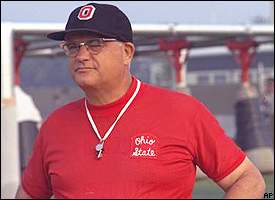
The Scarlet and Grey Program runs deep through every Ohioan’s veins and it’s the program itself within the Ohio State Athletic Department that has kept its foot on the gas pedal maintaining excellence in the sport. No TEAM in the United States by these measures consistently can measure up to the stature of Ohio State football and dispute Ohio State’s claim to be the Ground Zero of Pigskin.
Michigan Week Supersedes Life Itself!
Imagine you are a junior frat guy at The Ohio State University. You have finally figured out life,
where you are going and who you need to “buddy up to.” You also know who to stay away from, avoid non-PC actions, keep your mouth shut most of the time and be as cool as you can without being obnoxious. Your profs know that Michigan is headed to Ohio Stadium on Saturday, the entire world is going to be watching and you have 2 tickets (your roommate is in premed and gave his away at a weak moment). Better yet, you hang out at the right place with the right guys and find out the girl you most desire was dumped a couple weeks ago. Thus you ask her to the game and party afterwards, and she says OK. It doesn’t get any better than this as you know. All you need to do now is to somewhat behave at the game and you’re good. Here’s what you and your date can expect.
Arguably the Michigan–Ohio State rivalry ranks at the top of all sport face offs. There is a web site catering to this historical and yearly struggle “Beat Michigan Week.” The site characterizes and summarizes succinctly the rivalry with the following:
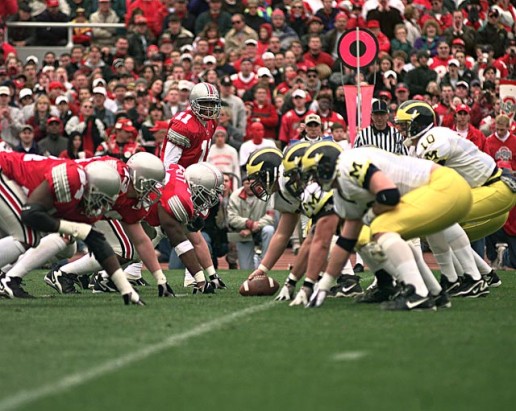
From ESPN’s 10 Greatest Rivalries:
“When Ohio Stadium opened in 1922, Michigan spoiled the party with a 22-0 victory. The rivalry was heated in the early days as both have been long time college
football powers. But it got even hotter in 1969 when Bo Schembechler took over as Michigan's coach and upset Woody Hayes' No. 1-ranked, undefeated Buckeyes. Four times in the next six years, both teams were ranked in the top five when they met. In 1970 and 1973, both were undefeated (they tied 10-10 in 1973). From 1970 through 1975, Michigan entered without a loss every year. The Wolverines won just once. Ohio State was 9-0-1 in 1993, 11-0 in 1995 and 10-0 in 1996. The Buckeyes lost each time.”
Trivia
- Ohio State didn’t win until the 16th game in the series (1919).
- From 1968 through 1980 (that’s a 13 year period) the Big Ten Rose Bowl representative was either Ohio State or Michigan.
- Jim Tressel was only the fourth coach in Ohio State football history to win his first game against Michigan and only the second Ohio State coach to start 2-0 against the Wolverines. The other was Francis Schmidt, who started 4-0 from 1934 to 1937.
- Schmidt also introduced the tradition of the "gold pants." After accepting the coaching position, he was asked how he expected to cope with the Ohio State nemesis from Ann
- Arbor. His matter-of-fact answer developed into a cliché: "They put their pants on one leg at a time same as everybody else." Schmidt’s comment led to the formation of the
- “Golden Pants Club,” which awarded miniature gold football pants to all players who had a hand in a victory over the Wolverines.
- Biggest margin of victory in the series for the Buckeyes was in Schmidt’s second season, 38-0 in Ann Arbor.
- Under Tressel, the Buckeyes posted an 8-1 record against arch-rival Michigan.
- This year (2012) will mark the 109th game between the two universities.
In essence, this site summarizes the historically intense college football rivalry within the Big
10. This is a golden period, and nothing lasts forever. Cable companies, conference
realignments, fan base, athletic budgets, NCAA probation and general economic conditions
affect many rivalries. As a child and young adult, the Nebraska–Oklahoma rivalry was clearly on the short list of pre-eminent college football grudge matches. Nowadays my very own boys look perplexed when I even discuss it: “Dad, they’re not even in the same conference any longer. It couldn’t have been that good!” However it truly was a great Thanksgiving game that always entertained and often carried national championship implications for both teams. Many students never went home. staying just for the Sooner–Cornhusker game. It superseded life itself, at least for those 3 plus hours. And for years many fans were able to discuss the game, look forward to next year’s game, and support a college with finances, good students or even just bravado.
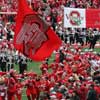
Michigan week has donative events, athletic contests, crafts, coaches-fans-player reunions
and breaks for many students from the college academic grind. Buckeye Battle Cry, Across the Field, Carmen Ohio, and Hang on Sloopy are heard throughout the campus. The Ohio State University comes to life throughout the week, preempting upcoming academic finals. The effects of this game on Ohio folks range from “I don’t care” (few) to blood boiling acquired disdain for anything or anyone north of Toledo. The history, lore and pageantry of college pigskin is best summarized by this rivalry game itself. Michigan week represents itself as the all time true testament to college football where it encompasses the unbridled gladiator competition between the youth and adult years. NCAA football in part rests upon this rivalry game. It doesn’t get any better than this: playing Michigan in late fall for all the marbles.
National championships, Big 10 titles, bowl berths, historical talk for years and maybe that frat
guy’s future with the sorority date rests upon this game. Michigan week suspends and
supersedes life itself for the true Buckeye fan base. This golden week has kept The Ohio State University strong in many ways and is the November “frosting on the cake” for Buckeye fans. Given their success, it’s hard to dispute an Ohioan regarding the top notch strength and
traditions of the Buckeye college football program. Rutherford B. Hayes not only propelled The Ohio State University to a “complete” university in all ways but in doing so he also laid the groundwork for The Ohio State pigskin predominance.
Steeped in its traditions, the Ohio State football program coupled with Ohio Stadium’s lore and true Buckeye fan base and the Michigan game rivalry allow The Ohio State University to stake claim to “Scarlet and Gray–Ground Zero of College Pigskin.”
|